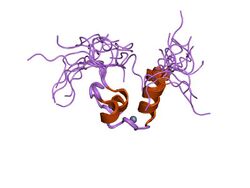Biology:DM domain
| DM domain | |||||||||
|---|---|---|---|---|---|---|---|---|---|
 Drosophila melanogaster doublesex (dsx), nmr, 18 structures | |||||||||
| Identifiers | |||||||||
| Symbol | DM | ||||||||
| Pfam | PF00751 | ||||||||
| InterPro | IPR001275 | ||||||||
| SMART | SM00718 | ||||||||
| SCOP2 | 1rvv / SCOPe / SUPFAM | ||||||||
| |||||||||
In molecular biology the DM domain is a protein domain first discovered in the doublesex proteins of Drosophila melanogaster and is also seen in C. elegans and mammalian proteins.[1] In D. melanogaster the doublesex gene controls somatic sexual differentiation by producing alternatively spliced mRNAs encoding related sex-specific polypeptides.[2] These proteins are believed to function as transcription factors on downstream sex-determination genes, especially on neuroblast differentiation and yolk protein genes transcription.[3][4]
The DM domain binds DNA as a dimer, allowing the recognition of pseudopalindromic sequences .[2][5][6] The NMR analysis of the DSX DM domain [6] revealed a novel zinc module containing 'intertwined' CCHC and HCCC zinc-binding sites. The recognition of the DNA requires the carboxy-terminal basic tail which contacts the minor groove of the target sequence.
Proteins with this domain
Proteins with the DM domain are found in many model organisms. Many C. elegans Mab proteins contain this domain, the best-known one being mab-3.[1] Human proteins containing this domain include DMRT1, DMRT2, DMRT3, DMRTA1, DMRTA2, DMRTB1, and DMRTC2; each of these have a mouse homolog.[7]
| Dmrt1-specific | |||||||||
|---|---|---|---|---|---|---|---|---|---|
| Identifiers | |||||||||
| Symbol | Dmrt1 | ||||||||
| Pfam | PF12374 | ||||||||
| InterPro | IPR022114 | ||||||||
| |||||||||
DMRT1 homologs have an additional common domain C-terminal to the DM domain. This domain is only found in bony vertebrates, and neither its structure nor function is unknown.[8](species tree) Jpred predicts the human version of the section to be mostly coils; it also suggests a weak similarity to PDB: 6BO4 by BLAST.[9]
| DMRTA motif | |||||||||
|---|---|---|---|---|---|---|---|---|---|
| Identifiers | |||||||||
| Symbol | DMA | ||||||||
| Pfam | PF03474 | ||||||||
| InterPro | IPR005173 | ||||||||
| |||||||||
DMRTA proteins have an additional motif in their C-termina. This motif, ubiquitous in eukaryotes, has an unknown function. It is similar in sequence to some ubiquitin-associated motifs.[10]
References
- ↑ 1.0 1.1 "Evidence for evolutionary conservation of sex-determining genes". Nature 391 (6668): 691–5. February 1998. doi:10.1038/35618. PMID 9490411. Bibcode: 1998Natur.391..691R.
- ↑ 2.0 2.1 "Functional and genetic characterization of the oligomerization and DNA binding properties of the Drosophila doublesex proteins". Genetics 144 (4): 1639–52. December 1996. doi:10.1093/genetics/144.4.1639. PMID 8978051.
- ↑ "The doublesex proteins of Drosophila melanogaster bind directly to a sex-specific yolk protein gene enhancer". EMBO J. 10 (9): 2577–82. September 1991. doi:10.1002/j.1460-2075.1991.tb07798.x. PMID 1907913.
- ↑ "mab-3, a gene required for sex-specific yolk protein expression and a male-specific lineage in C. elegans". Cell 54 (7): 1019–31. September 1988. doi:10.1016/0092-8674(88)90117-1. PMID 3046751.
- ↑ "Similarity of DNA binding and transcriptional regulation by Caenorhabditis elegans MAB-3 and Drosophila melanogaster DSX suggests conservation of sex determining mechanisms". Development 126 (5): 873–81. February 1999. doi:10.1242/dev.126.5.873. PMID 9927589.
- ↑ 6.0 6.1 "Sexual dimorphism in diverse metazoans is regulated by a novel class of intertwined zinc fingers". Genes Dev. 14 (14): 1750–64. July 2000. doi:10.1101/gad.14.14.1750. PMID 10898790.
- ↑ "Proteins matched: DM DNA-binding domain (IPR001275) filtered by species (Homo sapiens)". https://www.ebi.ac.uk/interpro/entry/IPR001275/proteins-matched?species=9606.
- ↑ "Family: Dmrt1 (PF12374)". http://pfam.xfam.org/family/PF12374.
- ↑ "Jpred results (MTECSGTSQPPPASVPTTAASEGRMVIQDIPAVTSRGHVENTPD)". http://www.compbio.dundee.ac.uk/jpred4/results/jp_EnccKEp/jp_EnccKEp.html.
- ↑ "Species: DMRTA motif (IPR005173)". https://www.ebi.ac.uk/interpro/entry/IPR005173/taxonomy.
 |

